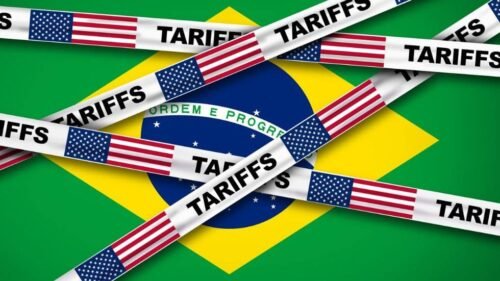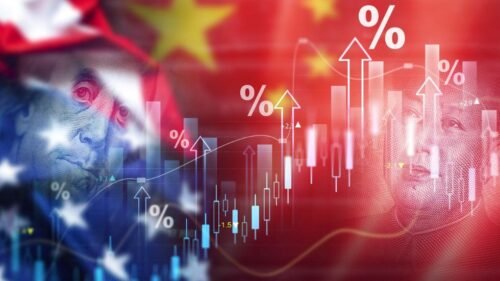Washington wants Seoul to write a big check in exchange for lower tariffs. After not getting its way, the United States Immigration and Customs Enforcement (ICE) arrested hundreds of Korean workers at Hyundai-LG’s Georgia battery site—a high-stakes attempt at shaking down a (supposed) ally for protection money.
The skirmish: tariffs for cash (and control)
In early 2025, the US slapped broad tariffs on Korean exports. During negotiations, the US offered to lower those tariffs if Korea pledged to invest a considerable amount of money in the US. The number that stuck was $350 billion from Seoul (as part of a larger US–Asia push), which the White House at times framed as “upfront” money.
However, Seoul pushed back, offering incremental, commercially justified projects, not a lump-sum transfer, and only with financial safeguards like a standing dollar swap line to prevent a balance-of-payments shock. Talks stalled; the won slid to ₩1,400 per dollar; and South Korean President Lee Jae-myung warned that agreeing on Washington’s terms could recreate a 1997-style crisis.
While some central banks enjoy standing (permanent) swap lines with the Federal Reserve, the Bank of Korea had only temporary, limited access on two occasions ($30 billion in October 2008, $60 billion in March 2020).
A swap line is an agreement between two central banks to exchange currencies now and swap them back later at a fixed rate. This enables the foreign central bank to lend dollars to its commercial banks during times of market stress without anyone taking currency risks.
Since a lot of lending and trade finance is conducted in US dollars, a financial crisis can lead to a dollar shortage, funding problems for corporations, and speculative attacks against the currency. This, in turn, could make raising interest rates necessary, potentially aggravating economic conditions.
Having a standing swap line of a decent size sends a message to speculators that any attempts to attack the currency would be futile.
The Georgia shock: 475 arrests at the EV hub
Then came the raid. On September 2–4, federal agents detained roughly 475 workers — mostly Korean nationals, many employed by subcontractors — at Hyundai Motor Group Metaplant America (HMGMA) and the adjacent LG Energy Solution (LGES) battery joint venture (JV) near Savannah, Georgia, the largest single-site immigration action in the United States Department of Homeland Security (DHS) history. Hyundai now expects the battery plant’s startup to slip by at least two to three months.
President Lee praised US President Donald Trump’s handling of the incident in public — a bid to keep lines open — but warned the broader climate could chill Korean capital in the US.
Georgia is the anchor of Korea’s US electric vehicle (EV) production plans. Hyundai’s Georgia build-out has a combined investment volume in the low double-digit billions — the auto plant and the battery joint-venture each costing around $7.5 billion. A construction-phase labor shock pushes back Inflation Reduction Act (IRA)-sensitive timelines and adds perceived “rule-of-law risk” to foreign capex.
A Big Ask
The US is offering lower tariffs (Korea seeks parity with Japan/EU around 15%) in exchange for a Korean-funded US investment vehicle of nearly $350 billion, with rapid disbursement and strong US say over where the money goes. That’s paired with pressure to re-shore or “friend-shore” sensitive supply chains and to align with US tech controls. The US is demanding that Korea hand over an amount equal to 20% of its GDP.
Seoul, however, is suggesting stretching the funding over years, replacing most of it through loans and guarantees, and getting a standing Fed swap line or an equivalent backstop (so the dollar reserves at the Bank of Korea aren’t depleted). Korea’s foreign exchange (FX) reserves were $416.3 billion at the end of August. Demanding that Korea hand over 84% of its dollar reserves seems neither reasonable nor practical.
Korean reactions
Lee has tried to run a two-track strategy: talk tough at home, pragmatic abroad. He flagged the currency risk (“without a swap, crisis risk rises”), criticized US control over any investment pool and simultaneously kept praise handy for Trump on the Georgia enforcement episode.
Politically, his approval has been whipsawed: it rebounded to 59–62% after his late-August US–Japan swing, then dipped toward 55% after the tariff standoff and FX jitters returned, narrowing his room for concessions.
The skirmish is unpopular. Surveys conducted in August showed most Koreans are opposed to tariffs and skeptical of the compromise; Pew also recorded a decline in Korean favorability toward the US this summer.
Impact on Korean battery manufacturing in the US
In the short term, the Georgia raid delays commissioning and creates supply-chain friction (visa checks, contractor audits, insurance repricing). Hyundai expects a delay of two to three months in the case that tariff relief doesn’t arrive. Korean autos and parts could face a price handicap into 2026, eroding the logic of US final assembly. Certain production steps face deadlines in order to qualify for IRA credits (US federal tax credits created by the 2022 Inflation Reduction Act to subsidize clean energy, EVs and domestic manufacturing).
For now, batteries could be sourced from other producers as a temporary patch. The broader effect is a chilling realization — “we invested billions, then got hit with raids and tariffs”.
Lithium Power Play
While the US Geological Survey (USGS) does not disclose domestic lithium production, it is estimated that the US currently has a global market share of less than 2%, stemming from a single mine. As electric vehicles replace ICE cars, access to inexpensive lithium becomes critical.
The “Thacker Pass” project in Nevada is expected to ramp up production in 2028, giving competitors in battery production a multi-year head start. The US Department of Energy intends to swap its $2.26 loan into a 5% equity stake in the company developing the lithium deposit (Lithium Americas). With General Motors being the main customer for lithium produced in Nevada, disrupting competitors, like Korean Hyundai, might have played a role in the ICE raids.
One nation’s trade surplus is another nation’s deficit
In 2024, the US exported $66 billion to and imported $132 billion from Korea, for a $66 billion US goods deficit, fueled by $50 billion in imports of autos and parts. The US enjoyed a $12 billion surplus in services, which partially mitigated the deficit in goods.
US trade deficits can be traced back to an overvaluation of the US dollar. By insisting on remaining the world’s reserve currency, surplus nations, like Korea, are forced to accumulate dollars as a safety cushion, to provide coverage for imports, and for lack of alternative uses. The natural adjustment in exchange rates, therefore, is not allowed to happen.
A weak currency would not be suitable for reserves; central banks would shun wasting assets, since losses would raise questions and potentially endanger their independence.
A foreign-sector surplus, from a US perspective, dictates that one or more domestic sectors must run a deficit, causing perennial US government fiscal deficits. Lacking domestic savings, the US is dependent on external financing, leading to increased indebtedness towards foreign investors. Billions of interest are due to friends and foes alike.
Russian dollar reserves were “neutralized” via sanctions. Now, the US has laid its eyes on other countries’ dollar stashes.
The Miran Plan spelled it out
Few should have been surprised by economic bullying from the US. All the steps, from tariffs to forced investments, have been laid out plainly by Stephen Miran, now Trump’s Chief Economic Advisor, in his 2024 paper “A User’s Guide to Restructuring the Global Trading System”. He writes: “There is another potential use of the leverage provided by tariffs … the removal of tariffs in exchange for significant industrial investment in the United States by our trading partners.”
So far, Trump has followed the Miran Plan diligently. The next step would shock foreign holders of Treasury securities: a withholding tax on interest. Instead of paying coupons to, say, the People’s Bank of China at 4%, the US Treasury would simply snip off 10 or 20%.
This would likely upset US trade partners even more, potentially leading to an accelerated dumping of US securities, with negative implications for the US dollar, too. It is not hard to see the adventure ending with an own goal.
[Kaitlyn Diana edited this piece.]
The views expressed in this article are the author’s own and do not necessarily reflect Fair Observer’s editorial policy.
Support Fair Observer
We rely on your support for our independence, diversity and quality.
For more than 10 years, Fair Observer has been free, fair and independent. No billionaire owns us, no advertisers control us. We are a reader-supported nonprofit. Unlike many other publications, we keep our content free for readers regardless of where they live or whether they can afford to pay. We have no paywalls and no ads.
In the post-truth era of fake news, echo chambers and filter bubbles, we publish a plurality of perspectives from around the world. Anyone can publish with us, but everyone goes through a rigorous editorial process. So, you get fact-checked, well-reasoned content instead of noise.
We publish 3,000+ voices from 90+ countries. We also conduct education and training programs
on subjects ranging from digital media and journalism to writing and critical thinking. This
doesn’t come cheap. Servers, editors, trainers and web developers cost
money.
Please consider supporting us on a regular basis as a recurring donor or a
sustaining member.
Will you support FO’s journalism?
We rely on your support for our independence, diversity and quality.








Comment